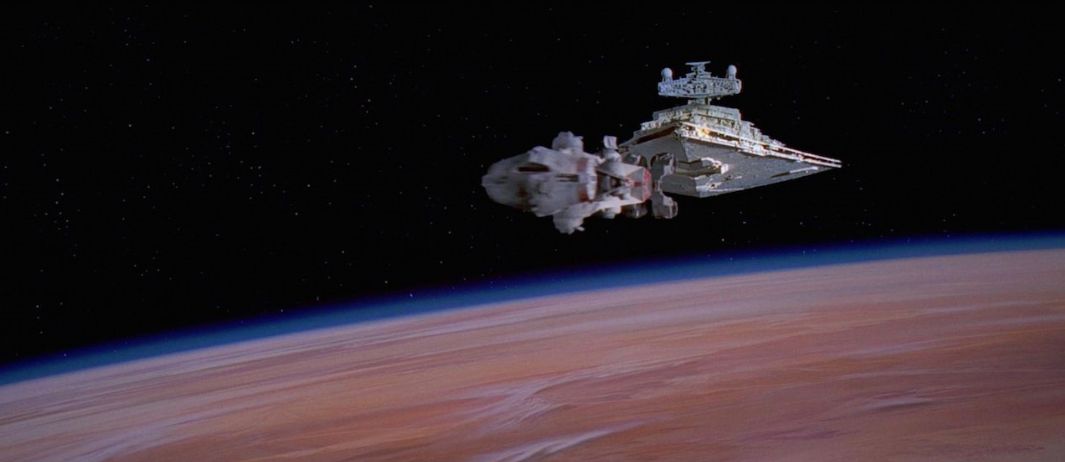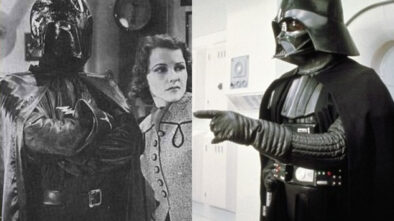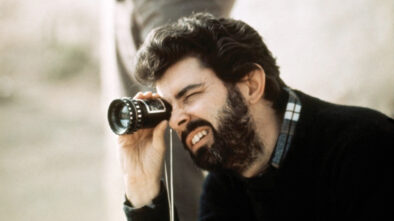Star Wars and ‘In Medias Res’: How Movie Serials Inspired A New Hope’s Iconic Opening Scene
Star Wars: A New Hope opens with John Williams’ rousing score that heralds a fast-paced action-adventure to come. An opening crawl establishes the brief context, informing the audience of the Rebels’ first victory, and a princess escaping in her starship with stolen plans of the Death Star, a space station that can destroy a planet. The crawl sets the scene, and through a few lines of text, the audience knows they’re entering a story that has been well underway for some time.
Then, with little warning, the audience is suddenly dropped right into the middle of a space battle. A tiny ship hurtles from overhead. The explosions and laser fire suggest it’s being chased. A moment later, the belly of a massive spaceship moves into frame from the top of the screen. The ship just seems to go on and on forever. The audience doesn’t know this ship is an Imperial Star Destroyer, but they’re clearly the bad guys. Its position at the top of the frame is oppressive; it’s almost as threatening to the audience as it is to its small quarry. This small ship must be the princess’ starship mentioned in the opening crawl. Outgunned and outmatched, the small ship is soon disabled and the Star Destroyer looms directly over it. Will the princess and the stolen plans be discovered?
Even 45 years on, the pure excitement of these first few frames hooks the viewer immediately. We haven’t seen the princess yet, and Darth Vader is still moments away from making his iconic entrance. Even the hero, Luke Skywalker, doesn’t make his entrance for another 15 minutes. We have very little to go on. Yet, we’re hooked, completely drawn into this strange new environment set in a galaxy far, far away. Many filmmakers have tried to recapture the excitement of this sequence in their work. But to discover what inspired director George Lucas to create this sequence, we have to look back in time to the Flash Gordon movie serials of the 1930s and a storytelling device called ‘in medias res’.

The Latin term, which translates to “in the middle of things”, is credited to the Roman poet Horace around 13 B.C.E. When a filmmaker or writer uses ‘in medias res’, they waste no time and start the opening scene in the thick of it, right in the middle of the action. Typically in an action film, this means the film begins in the middle of a battle, a chase, or some sort of conflict. When a story is begun in the middle of the action, the inciting incident that sets the story in motion and causes the characters to act takes place before the film or book begins. Context is filled in as the story progresses through dialog, flashbacks, or another recount of past events.
Done well, ‘in medias res’ does not confuse the audience. Rather, it creates suspense and intrigue–the essence of hooking an audience. The audience has to use their imagination to fill in the gaps until additional information is made clear as the story unfolds. The opening scene of Star Wars: A New Hope works well in this regard because it is simple. There are only two spacecraft, and the size and position of the Star Destroyer make it clear who the aggressor is, even if the audience didn’t read the opening crawl.
‘In medias res’ is an ancient storytelling device first used in the epic poems of Homer but it arguably has more impact in the visual medium of film. For George Lucas, it wasn’t Homer’s Odyssey that inspired him to use the storytelling device, but the old Saturday movie serials. During his formative years, the young George Lucas had been enthralled by reruns of movie serials, especially Flash Gordon. These old movie serials–or “cliffhangers”–were typically divided into 12-episodes, with each episode lasting between 10 to 20 minutes. After Lucas couldn’t get the movie rights to Flash Gordon, he would use the serial as a key inspiration for his own space opera. Like serials, he originally envisaged Star Wars as a 12-part series, which over the years was whittled down to nine parts, then six, and then back up to nine parts when Disney showed interest in purchasing LucasFilm.
One element that particularly intrigued Lucas was how serials got the audience hooked into returning the following week for the next episode. A serial’s new episode was screened weekly at the cinemas before a feature film. Audiences were hooked into returning the following week because each episode ended with an impossible situation where the hero seemed to die. Often the hero was seen falling off a cliff or from a great height or going over the edge in some out-of-control vehicle, which earned movie serials the nickname “cliffhangers.”
Movie serials used ‘in medias res’ at the beginning of each new episode as a recap of the previous week’s cliffhanger. The recap would replay the cliffhanger exactly, except for the insertion of additional footage which showed how the hero survived. A comparison of the cliffhanger and its recap showed how an editor can omit just a few frames of footage to give the effect that someone died. Some may argue that these recaps are not a pure form of ‘in medias res’ because the previous episode gave audiences narrative context. In literature and a standalone film, ‘in medias res’ typically begins a story in the midst of the action or the plot. Context is filled in as the story progresses through dialog or flashbacks or another recount of past events. In serials, however, ‘in medias res’ was directly tied to their episodic nature. ‘In medias res’ was only used as a recap of the ending of a previous episode, never to open the first episode of a serial.

However, movie studios made each episode relatively self-contained so a viewer who had missed previous installments could start watching the serial from any episode and catch up. There was typically a loose overall plot for the whole serial, but each episode had a particular mission or task for the hero to complete. The recap served as a thrilling and fun action sequence to hook the new viewer into the story immediately.
Lucas would borrow the concept of cliffhangers and their recap for his two major franchises, Indiana Jones and Star Wars. While the Indiana Jones series repeatedly pays homage to cliffhangers, Star Wars often uses ‘in medias res’ to begin a film. With his opening scene in Star Wars: A New Hope, Lucas wanted to emulate the notion that the audience had walked into the cinema to see the middle episode of a serial.
Before the film’s release, Lucas wanted to add either episode III or IV to the beginning of the opening crawl, but 20th Century Fox refused. The executives at Fox thought audiences would be confused by the story. But Lucas ultimately prevailed once he gained more control over his franchise with the sequel, The Empire Strikes Back. Ahead of its release in 1980, he announced the sequel would be ‘Episode V’ in the Star Wars saga. A year later, Star Wars was re-released with a new title card leading the opening crawl: ‘Episode IV A NEW HOPE’.
The opening crawl, while reminiscent of the text that appeared at the beginning of each serial episode, is a direct homage to Flash Gordon Conquers the Universe (1940). The serial is the only serial to use the distinctive opening crawl. Below, a video comparison of the crawls from Flash Gordon Conquers the Universe and Star Wars: A New Hope shows their similarities. Lucas used a similar font and writing style. He even ended the last paragraph with four dots like the roll-up in Flash Gordon Conquers the Universe.
Beginning each Star Wars film with the opening crawl was Lucas’ way of heralding that Star Wars was a homage to Flash Gordon. Though the opening crawl pays homage directly to Flash Gordon Conquers the Universe, Lucas references all the Flash Gordon serials and original comic strips throughout the Star Wars saga. Lucas’ opening in A New Hope also improved on the serial’s use of ‘in medias res’, not only with improved special effects and Williams’ musical score but also with the removal of the credits at the beginning. He knew the credits detracted from the surprise opening.
Lucas’ use of ‘in medias res’ at the beginning of Star Wars: A New Hope helped turn the film’s opening scene into one of the most iconic moments in cinema, overshadowing the influence of Flash Gordon Conquers the Universe. Lucas, though, invariably mentions the importance of movie serials on Star Wars’ creation in almost every interview on the series. Over the years, he retroactively added more elements to Star Wars: A New Hope to connect the film to its movie serial origins, especially starting his film series in the middle of the saga, an idea that would have made Star Wars a cinematic oddity in 1977. But by the release of Empire in 1980, the idea made the Star Wars universe even more intriguing and helped fuel fans’ desire for a prequel trilogy of a young Obi-Wan Kenobi, Darth Vader, and the Clone Wars. Without Lucas’ use of ‘in medias res’ and his love for the episodic nature of movie serials, Star Wars would probably never have expanded into the cinematic universe it is today.




